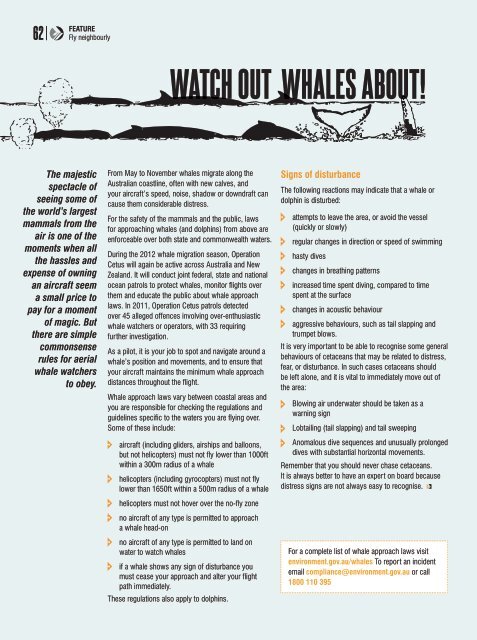jul-aug2012
Create successful ePaper yourself
Turn your PDF publications into a flip-book with our unique Google optimized e-Paper software.
62<br />
FEATURE<br />
Fly neighbourly<br />
WATCH OUT WHALES ABOUT!<br />
The majestic<br />
spectacle of<br />
seeing some of<br />
the world’s largest<br />
mammals from the<br />
air is one of the<br />
moments when all<br />
the hassles and<br />
expense of owning<br />
an aircraft seem<br />
a small price to<br />
pay for a moment<br />
of magic. But<br />
there are simple<br />
commonsense<br />
rules for aerial<br />
whale watchers<br />
to obey.<br />
From May to November whales migrate along the<br />
Australian coastline, often with new calves, and<br />
your aircraft’s speed, noise, shadow or downdraft can<br />
cause them considerable distress.<br />
For the safety of the mammals and the public, laws<br />
for approaching whales (and dolphins) from above are<br />
enforceable over both state and commonwealth waters.<br />
During the 2012 whale migration season, Operation<br />
Cetus will again be active across Australia and New<br />
Zealand. It will conduct joint federal, state and national<br />
ocean patrols to protect whales, monitor flights over<br />
them and educate the public about whale approach<br />
laws. In 2011, Operation Cetus patrols detected<br />
over 45 alleged offences involving over-enthusiastic<br />
whale watchers or operators, with 33 requiring<br />
further investigation.<br />
As a pilot, it is your job to spot and navigate around a<br />
whale’s position and movements, and to ensure that<br />
your aircraft maintains the minimum whale approach<br />
distances throughout the flight.<br />
Whale approach laws vary between coastal areas and<br />
you are responsible for checking the regulations and<br />
guidelines specific to the waters you are flying over.<br />
Some of these include:<br />
aircraft (including gliders, airships and balloons,<br />
but not helicopters) must not fly lower than 1000ft<br />
within a 300m radius of a whale<br />
helicopters (including gyrocopters) must not fly<br />
lower than 1650ft within a 500m radius of a whale<br />
helicopters must not hover over the no-fly zone<br />
no aircraft of any type is permitted to approach<br />
a whale head-on<br />
no aircraft of any type is permitted to land on<br />
water to watch whales<br />
if a whale shows any sign of disturbance you<br />
must cease your approach and alter your flight<br />
path immediately.<br />
These regulations also apply to dolphins.<br />
Signs of disturbance<br />
The following reactions may indicate that a whale or<br />
dolphin is disturbed:<br />
attempts to leave the area, or avoid the vessel<br />
(quickly or slowly)<br />
regular changes in direction or speed of swimming<br />
hasty dives<br />
changes in breathing patterns<br />
increased time spent diving, compared to time<br />
spent at the surface<br />
changes in acoustic behaviour<br />
aggressive behaviours, such as tail slapping and<br />
trumpet blows.<br />
It is very important to be able to recognise some general<br />
behaviours of cetaceans that may be related to distress,<br />
fear, or disturbance. In such cases cetaceans should<br />
be left alone, and it is vital to immediately move out of<br />
the area:<br />
Blowing air underwater should be taken as a<br />
warning sign<br />
Lobtailing (tail slapping) and tail sweeping<br />
Anomalous dive sequences and unusually prolonged<br />
dives with substantial horizontal movements.<br />
Remember that you should never chase cetaceans.<br />
It is always better to have an expert on board because<br />
distress signs are not always easy to recognise.<br />
For a complete list of whale approach laws visit<br />
environment.gov.au/whales To report an incident<br />
email compliance@environment.gov.au or call<br />
1800 110 395

















